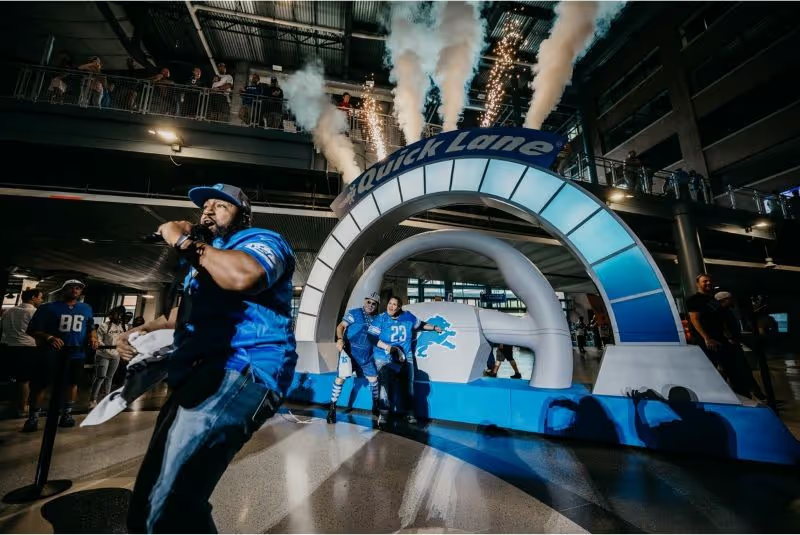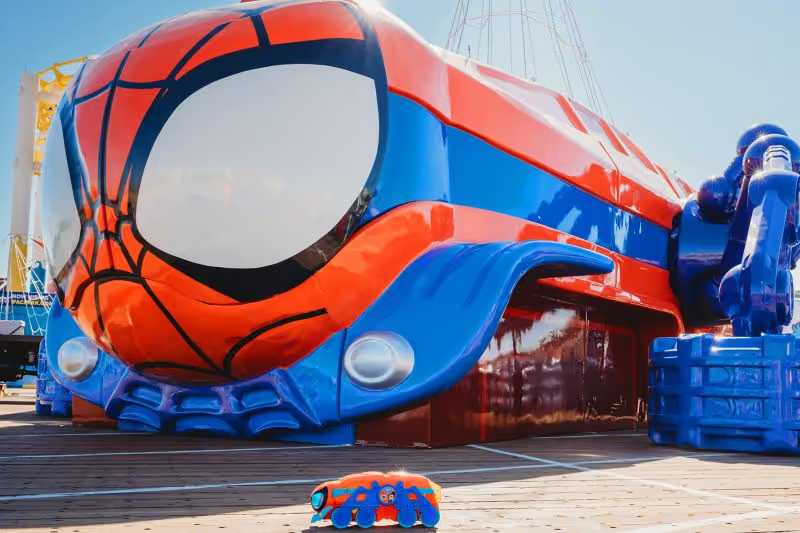Brand Activation Photography: Documentation Worth the Investment
Brand activation photography documents live events and records the moments that matter most to your campaign's success. When brands invest in mobile tours, pop-ups, or experiential campaigns, professional photography creates content that proves ROI and drives future marketing efforts.
Planning Your Brand Activation Photography Strategy
Photography planning starts during the design phase, not the day of your event. Marketing teams, brand reps, and production crews need to sync up early to identify the shots that will deliver the biggest impact for your campaign. Getting this right from the start means you'll have the content you need when deadlines hit:
Study the history of brand activations, and you'll see one pattern: events that generated buzz always had photo-worthy moments built in.
Pre-Event Photography Timeline and Preparation
Photography prep begins when you're still sketching activation layouts and mapping out how people will move through your space. Site visits reveal the best angles for crowd shots and close-ups, while power sources and venue restrictions shape your equipment decisions. Your timeline needs to factor in when crowds peak, when lighting works best, and which moments absolutely can't be missed.
Shot List Development for Maximum Brand Impact
Your shot list determines whether you walk away with content that actually moves the needle or just generic event photos. Smart planning means knowing exactly what moments will prove your activation worked and which shots will fuel your next campaign:
- Wide Environmental Shots: Show the full activation setup, including custom builds, branded installations, and how crowds flow through your space
- Consumer Interaction Moments: Get real reactions at photo booths, sampling stations, and hands-on product demos where people actually engage
- Brand Identity Documentation: Record every branded element from custom signage to fabricated props that reinforce your messaging
- Social Media Content Creation: Frame shots for Instagram stories, TikTok posts, and LinkedIn updates with proper vertical and square formats
- Product Integration Shots: Document product displays, sampling moments, and giveaway distributions as they happen naturally
Your activation visual design determines whether photographers walk away with content worth using or generic event shots.
Team Coordination and Brand Representative Alignment
Photography teams work directly with brand ambassadors, activation staff, and client reps to nail down messaging priorities and visual guidelines before the event begins. Clear communication channels keep everyone aligned during live events, while backup plans handle weather delays and equipment issues. Quick approval processes mean content goes live while people are still talking about the experience.
Professional Photography Equipment and Technical Specifications
Camera Systems and Lens Selection for Versatile Coverage
Two cameras keep you shooting even when one goes down, plus you can grab wide shots of the crowd while getting close-ups of people trying products. Full-frame cameras work better in dim indoor spaces, and weather-sealed bodies survive outdoor events and mobile tour road conditions. Pack a 24-70mm f/2.8 for most situations, an 85mm f/1.8 for people shots, and a 16-35mm f/2.8 when you need to show the whole scene.
Lighting Solutions for Indoor and Outdoor Brand Events
Lighting makes or breaks your photos, especially when moving from a bright outdoor festival to a dimly lit trade show booth on the same day. The right lighting setup works fast and doesn't get in people's way:
- LED Panel Systems: Keep colors consistent, whether you're under fluorescent lights or natural sunlight, without blocking foot traffic
- Battery-Powered Strobes: Handle product shots at mobile tour stops where you can't count on venue power or outlets
- Reflector Positioning: Bounce existing light back onto your subjects without hauling extra gear or finding power sources
- Custom Backdrop Lighting: Make photo booth areas and branded installations pop without washing out logos or messaging
- Portable Power Solutions: Keep shooting all day at remote locations where outlets are scarce or nonexistent
Documentation Systems for Real-Time Content Delivery
Getting photos from the camera to social media fast can make the difference between trending content and yesterday's news. Wireless setups let clients see shots as they happen and approve posts on the spot. Dual memory cards mean you won't lose a day's work if one fails, and mobile editing apps let you polish images between takes so content is ready to publish before the event wraps.
Advanced Photography Techniques for Brand Activation Events
Great activation photography does more than document what happened—it tells the story of why people showed up and what they felt when they got there. The difference between snapshots and campaign-worthy content comes down to knowing when to step back for the big picture and when to get close enough to see genuine reactions:
Authentic Consumer Engagement and Interaction Documentation
Real reactions happen when people forget they're being photographed, which means staying far enough away that they act natural. Longer lenses let you catch those genuine moments—the surprise when someone tastes a new product or the laughter at a photo booth—without getting in anyone's face. Position yourself where the action builds up, like right after people finish an experience when they're still buzzing about it.
Product Integration Within Live Brand Activations
Products should look good in photos without the shots feeling like obvious ads—people can spot staged product placement from a mile away. The best product shots happen during actual use, not posed setups:
- Sampling Station Documentation: Shoot people's first reactions when they try products at mobile tour stops, not the handoff moment
- Custom Display Photography: Show off fabricated showcases and branded installations when crowds are around them, not empty
- Interactive Product Moments: Get close during demos and try-on sessions when people are focused on the product, not the camera
- Branded Props Integration: Work custom signage and fabricated elements into crowd shots where they feel like part of the scene
- Purchase Point Documentation: Document the moment people decide to buy or take branded items home, capturing that conversion point
Social Media Optimized Composition and Content Creation
Instagram stories need vertical shots, LinkedIn posts work better horizontally, and TikTok clips require different framing than static posts. Shoot with multiple formats in mind so you're not scrambling to crop later. Leave space around key branded elements so logos and messaging don't get cut off when platforms auto-crop, and think about where text overlays will go before you press the shutter.
Post-Production and Digital Asset Management
Event photography generates thousands of images that need quick turnaround for social media posts, press releases, and campaign reports. The Detroit Lions NFL Draft activation produced content across multiple zones—from the Ford Field tunnel replica to the Coach Dan Campbell Zoltar machine—requiring organized workflows to deliver usable assets while buzz was still building:

Brand Consistency Through Professional Editing Workflows
The Lions' activation moved from bright outdoor spaces to dim indoor areas, but team colors needed to match across every photo. Arena lighting made the signature Honolulu Blue look different than natural daylight shots, requiring color correction that maintained brand standards without making images look artificial.
Client Delivery Systems and Digital Sharing Organization
Fast delivery and innovative organization help advertising teams use photos while events are still generating buzz:
- Cloud-Based Gallery Access: Upload finished photos where creative teams can download content immediately, with usage rights clearly defined for each tour stop
- Metadata Collection: Tag photos with venue details, crowd demographics, and activation zones so teams can locate specific content months after events end
- Brand Consistency Controls: Apply consistent color corrections across all delivered photos, whether shot at outdoor stadiums or indoor arenas
- Social Media Optimization: Export content in Instagram story, TikTok, and LinkedIn post formats so teams can publish without additional resizing
- Analytics Integration: Track which activation photos generate the most engagement to inform future tour stop photography priorities
Getting Started with Photo Booth Brand Activation Documentation
Photo booth brand activation setups create structured photography opportunities that generate consistent branded content throughout events. The Disney Spidey activation included multiple photo moments—from the optical illusion "Hang with Heroes" setup to the custom obstacle course finish line—that required strategic documentation planning.

Start by identifying which branded photo opportunities will generate the most social sharing potential, then plan photography coverage to capture both the photo booth interactions and genuine participant reactions for maximum content value.
Activate: We Build the Experiences Worth Photographing
Activate designs and produces brand activations, mobile tours, and premium PR boxes for global brands. Our 75,000 sq ft Detroit facility handles fabrication, fulfillment, and logistics from start to finish. We build the experiences that create photo-worthy moments your marketing team enjoys using. Email NewBusiness@Activateexp.com to start planning your next activation.
Frequently Asked Questions
What is branding photography?
Branding photography creates visual content that communicates brand identity and values through professional documentation of products, services, and consumer interactions. This specialized photography captures authentic moments during experiential marketing events, mobile tours, and branded experiences that reinforce brand messaging across digital sharing platforms and marketing strategy materials.
How to do a brand activation?
Brand activation execution requires strategic planning that begins with understanding target audience demographics, campaign objectives, and measurable success metrics before designing immersive experiences. Professional activation development includes custom fabrication, branded installations, interactive elements, and comprehensive logistics management from concept through post-event analysis to deliver authentic consumer engagement and quantifiable business outcomes.
